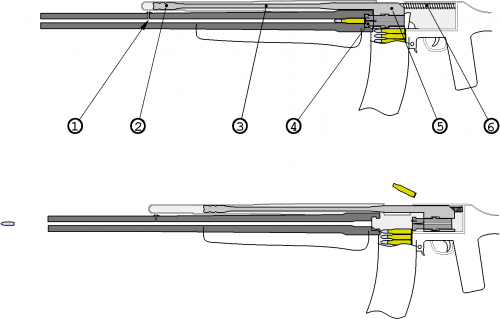Gas-operated reloading
Gas-operation is a system of operation used to provide energy to operate autoloading firearms. In gas-operation, a portion of high pressure gas from the cartridge being fired is used to power a mechanism to extract the spent case and chamber a new cartridge. Energy from the gas is harnessed through either a port in the barrel or trap at the muzzle. This high-pressure gas impinges on a surface such as a piston head to provide motion for unlocking of the action, extraction of the spent case, ejection, cocking of the hammer or striker, chambering of a fresh cartridge, and locking of the action.
Contents[hide] |
[edit] Gas systems
[edit] Short stroke
A short-stroke gas system is defined as one that diverts high pressure gas from the middle or rear portion of the barrel that impinges on the piston head for a short period of time before excess gas is either cut-off (M14), vented (AK-47), or the piston head reaches a stop (M1 Carbine).[1] The distance the piston travels under pressure is generally less than its diameter.[2] The piston may or may not be attached to the bolt carrier. This is the most common type of gas operation.
[edit] Long stroke
A long-stroke gas system is generally defined as one which the stroke of the piston under pressure is greater than its diameter.[3] Because of the greater dwell time, gas must be ported from the barrel very near the muzzle of the weapon as in the M1 Garand. This relatively lower pressure gas acts over a longer period of time to impart the same amount of energy to the operating system. Because the operating parts are longer, they are necessarily heavier and this system is not used in modern weapons.
[edit] Gas trap
A gas trap system is similar to long-stroke operation, however gas is 'trapped' after leaving the muzzle. The Bang rifle and early gas trap Garand rifles use this system.
[edit] Direct impingement
- Main article: Direct impingement
The direct impingement method of operation vents gas through a tube to the working parts of a rifle where they directly impinge on the bolt carrier. Rifles that use this system include the M16 and French MAS-49.
[edit] Muzzle booster
- Main article: Muzzle booster
The German MG-42 machine gun and other short-recoil operated firearms use a gas trap style mechanism to provide energy in combination with recoil energy. This 'boost' provides higher rates of fire and/or more reliable operation. It is alternately called a gas assist.
[edit] Misconceptions
The terms short-stroke and long-stroke are often confused by both laymen and experts. The stroke is that portion of time when combustion gases contact the piston head prior to venting. It is not the total length the piston head might travel during the cycling of the action. The commonly reported misconception is that a piston being rigidly affixed to the bolt carrier is what constitutes a long-stroke system. The AK-47 is commonly referred to as a long-stroke action while the Armalite AR-18 is often used as an example of a short-stroke system. In fact, the stroke is virtually the same and the gas port is in nearly the same location along the barrel for both rifles.
[edit] Other autoloading systems
Other autoloading systems are:
- Recoil operation uses the rearward movement of parts of the weapon in response to the bullet moving forward, as described by Newton's third law of motion.
- Gatling and other mechanical means utilize mechanical energy from an operator turning a crank.
- Chain and others utilize external power through electrical or hydraulic energy for operation.
- Blowback firearms use the expanding gas impinging on the cartridge itself to push the bolt of the firearm rearward.
[edit] References
- ↑ Hatcher, Julian. (1947). Hatcher's Notebook. The Military Service Press Company. ISBN 0-8117-0795-4 p. 67
- ↑ Dictionary of Automotive Terms Abbreviations
- ↑ On Guard, the Story of the Rapier
[edit] External links
- Gas operation, Animation and explanation at howstuffworks.com

